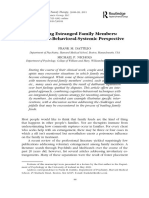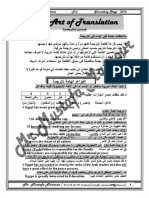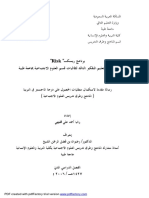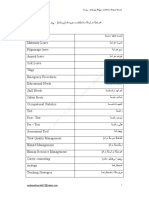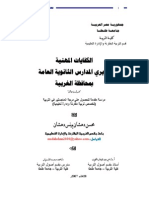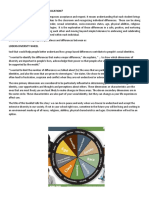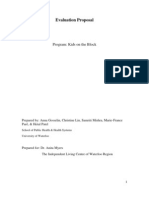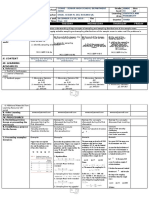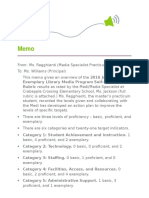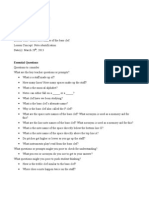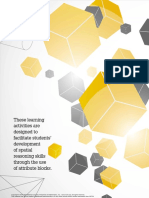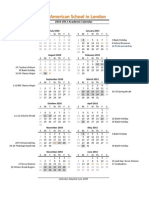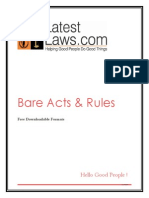7e Model
7e Model
Uploaded by
Tin AcidreCopyright:
Available Formats
7e Model
7e Model
Uploaded by
Tin AcidreOriginal Title
Copyright
Available Formats
Share this document
Did you find this document useful?
Is this content inappropriate?
Copyright:
Available Formats
7e Model
7e Model
Uploaded by
Tin AcidreCopyright:
Available Formats
7E MODEL
At first, I thought using the 5E Model would be better than the 7E because I like to keep
things simple. The 4E Model was too simple and on the other hand I found the 7E a bit
complicated because it involved more steps compared to the 5E. But, as I was watching
the video, I found out that the 7E model was an extension of the 5E Constructivist
Learning Cycle, and the reason why it involved more steps was it provided a clearer
rational framework for constructing a Science Lesson Plan. For this reason, I would
likely use the 7E model in constructing the lesson plan which can also be really useful
especially when the lesson to be taught is complex and really needs to be discussed
well.
The 7E Model stands for Elicit, Engage, Explore, Explain, Elaborate, Evaluate,
and Extend. What made it different from the 5E was the additional of the first and last
step which is Elicit and Extend. The teacher will start first with the “Elicit” where they can
find out the students’ prior knowledge through relevant questioning or provision of
appropriate situations. It is also a good opportunity to deal with students’
misconceptions about the lesson to be discussed. Then, this model ends with “Extend”
which aims to provide additional support to the learners – enrichment activities can be
given to those who can easily cope up with the lessons, and remediation for those who
are struggling. Because of this, I found the 7E model really great to use, as it was able
to employ such steps which helps address students’ needs and problems, and helps in
constructing a better lesson plan, which can also improve how lessons will be carried
out by teachers.
As for the remaining five steps, the 7E and 5E are already similar. “Engage” –
this is where teachers capture the students’ interest and provide them an opportunity to
express what they know about the concept or skills being developed and make
connection between their prior and new knowledge; “Explore” – this is where hands-on
activities allow students to acquire experience to make sense of new concept or skill
because the more the self is involved, the deeper the processing and understanding is ;
“Explain” – this is where the formal discussion takes place and concepts and terms are
provided by teachers to explain what the students have experienced; “Elaborate” – this
is where students are exposed to alternatives or more advanced applications; and,
“Evaluate” – this is where students can review and reflect on their own learning and
understanding, and at the same time, teachers with their teaching.
You might also like
- علم النفس الصحي - شيلي تايلورDocument848 pagesعلم النفس الصحي - شيلي تايلورnazihchekkNo ratings yet
- General Science ReviewerDocument1 pageGeneral Science ReviewerTin Acidre0% (1)
- Melting Moments - Chemical Sciences ProgramDocument4 pagesMelting Moments - Chemical Sciences Programmiffymoolive100% (1)
- استمارة تقيم حالة تلعثمDocument3 pagesاستمارة تقيم حالة تلعثمSihem Hamzaoui100% (1)
- 15 - إرساء ثقافة مدرسيةDocument143 pages15 - إرساء ثقافة مدرسيةNasser AltobiNo ratings yet
- Dattilio and Nichols (2011)Document13 pagesDattilio and Nichols (2011)janeNo ratings yet
- Bowtech ProspectusDocument13 pagesBowtech Prospectuslacifasza50% (4)
- استراتيجيات التدريس لذوي الاعاقة السمعيةDocument13 pagesاستراتيجيات التدريس لذوي الاعاقة السمعيةmimimil0707No ratings yet
- دليل الصحة النفسية المدرسية 3Document164 pagesدليل الصحة النفسية المدرسية 3ghaniaouadah82No ratings yet
- JFUST - Volume 14 - Issue 3 - Pages 1-57Document57 pagesJFUST - Volume 14 - Issue 3 - Pages 1-57noha alsaidNo ratings yet
- نماط الاتصال وعلاقتها ب جودة الحياة الزوجيةDocument212 pagesنماط الاتصال وعلاقتها ب جودة الحياة الزوجيةjihad munshiNo ratings yet
- Maereg TaDocument71 pagesMaereg TaAderaw GashayieNo ratings yet
- تصور لبرنامج تدريبي مقترح لتنمية الكفايات التدريسية الأساسية لدى مدرسي المرحلة الابتدائيةDocument14 pagesتصور لبرنامج تدريبي مقترح لتنمية الكفايات التدريسية الأساسية لدى مدرسي المرحلة الابتدائيةMohammed AbozyadNo ratings yet
- ما وراء التقويم التكوينيDocument222 pagesما وراء التقويم التكوينيtareq shehadehNo ratings yet
- JSSWH Volume 52 Issue 2 Pages 461-500Document40 pagesJSSWH Volume 52 Issue 2 Pages 461-500Sara fahadNo ratings yet
- نموذج تقييم ذاتي لملف الطالبDocument2 pagesنموذج تقييم ذاتي لملف الطالبsfatani1No ratings yet
- دور وأهمية إرساء ثقافة حوكمة الشركات على استدامة الشركات الناشئة دراسة ميدانيةDocument22 pagesدور وأهمية إرساء ثقافة حوكمة الشركات على استدامة الشركات الناشئة دراسة ميدانيةChaouki Nsighaoui0% (1)
- التفكير المنهجي@@Document11 pagesالتفكير المنهجي@@تميم التميميNo ratings yet
- جودة الحياة الزوجية وأثرها على الأبناءDocument20 pagesجودة الحياة الزوجية وأثرها على الأبناءjihad munshiNo ratings yet
- واقع الابتكار الحكومي في الدول العربية وسبل تطويرهDocument17 pagesواقع الابتكار الحكومي في الدول العربية وسبل تطويرهKasem Al ShaghouriNo ratings yet
- Visual Management Tools: Tilhaong Elementary SchoolDocument4 pagesVisual Management Tools: Tilhaong Elementary SchoolAna Marie Sala100% (1)
- المشكلات السلوكية الصفية ماهيتها وأسبابها وطرق علاجها والتعامل معهاDocument30 pagesالمشكلات السلوكية الصفية ماهيتها وأسبابها وطرق علاجها والتعامل معهاsun moonNo ratings yet
- PQASSO Quality Mark Guidance On PQASSO Indicators: Levels 1 & 2Document42 pagesPQASSO Quality Mark Guidance On PQASSO Indicators: Levels 1 & 2Jamal Al-JabouriNo ratings yet
- نموذج مقترح لتطبيق نظام التكاليف المبني على الأنشطة في مستشفى غزة الأوروبيDocument233 pagesنموذج مقترح لتطبيق نظام التكاليف المبني على الأنشطة في مستشفى غزة الأوروبيخليل إبراهيم شقفة100% (1)
- الكفايات والتمثلات في التعليمDocument13 pagesالكفايات والتمثلات في التعليمhatim20210812No ratings yet
- دراسة تقويم برامج الماجستير وفق نموذج هاموندDocument32 pagesدراسة تقويم برامج الماجستير وفق نموذج هاموندأبو مهندNo ratings yet
- The Art of TranslationDocument39 pagesThe Art of TranslationAshraf Monir0% (1)
- O General Rules For The Guidelines For Final ReportDocument5 pagesO General Rules For The Guidelines For Final ReporteyasNo ratings yet
- بيداغوجيا المشروع PDFDocument3 pagesبيداغوجيا المشروع PDFLob NaNo ratings yet
- 10 1 1 662 7398Document19 pages10 1 1 662 7398somayaNo ratings yet
- اهمية تطبيقات الذكاء الاصطناعيDocument24 pagesاهمية تطبيقات الذكاء الاصطناعيali dokriNo ratings yet
- ديداكتيك القراءة المنهجية للنصوص القرائيةDocument11 pagesديداكتيك القراءة المنهجية للنصوص القرائيةتعليم جديدNo ratings yet
- 89 Dawor MNHJ BahmhmDocument338 pages89 Dawor MNHJ BahmhmSarah SNo ratings yet
- اﻹدارة ﺑﺎﻟﻘﻴﻢ وﺗﺤﻘﻴﻖ اﻟﺘﻮاﻓﻖ اﻟﻘﻴﻤﻲ ﻓﻲ اﻟﻤﻨﻈﻤﺎتDocument37 pagesاﻹدارة ﺑﺎﻟﻘﻴﻢ وﺗﺤﻘﻴﻖ اﻟﺘﻮاﻓﻖ اﻟﻘﻴﻤﻲ ﻓﻲ اﻟﻤﻨﻈﻤﺎتMahmoud JaouadiNo ratings yet
- بحث مستوى القدره على التفكير التأملى لدى معلمي في غزه 2011Document42 pagesبحث مستوى القدره على التفكير التأملى لدى معلمي في غزه 2011isamalhassanNo ratings yet
- الدراسة الجامعية للطالبة المتزوجة وانعكاساتها على حياتها الاجتماعيةDocument133 pagesالدراسة الجامعية للطالبة المتزوجة وانعكاساتها على حياتها الاجتماعيةSiham elsharifNo ratings yet
- MAED - Volume 119 - Issue 3 - Pages 1315-1356Document41 pagesMAED - Volume 119 - Issue 3 - Pages 1315-1356ahaia9023No ratings yet
- مساهمة تكنولوجيا التعليم في تحسين العملية التعليميةDocument13 pagesمساهمة تكنولوجيا التعليم في تحسين العملية التعليميةawsabualfawaresNo ratings yet
- دور إستراتجية إدارة العلاقة مع العميل في تحسين الصورة الذهنية للمؤسسات الخدمية دراسة حالة - الوكالة السياحية أماكن بالجلفة.Document22 pagesدور إستراتجية إدارة العلاقة مع العميل في تحسين الصورة الذهنية للمؤسسات الخدمية دراسة حالة - الوكالة السياحية أماكن بالجلفة.Alaa SiNo ratings yet
- JSFC Volume 10 Issue 1 Pages 1-33Document32 pagesJSFC Volume 10 Issue 1 Pages 1-33Cc BbNo ratings yet
- Ed532354 PDFDocument18 pagesEd532354 PDFAhmed HammadNo ratings yet
- نظام الجودة الشاملة كآلية لتحسين تنافسية الجامعات.Document18 pagesنظام الجودة الشاملة كآلية لتحسين تنافسية الجامعات.Ahmed AbdelradyNo ratings yet
- المخاطر التنظيميةDocument21 pagesالمخاطر التنظيميةمحمد السقاف100% (1)
- أثر تطبيق مبادئ إدارة الجودة الشاملة على الإنتاجية - مبادئ جائزة الملك عبد العزيز للجودة -Document43 pagesأثر تطبيق مبادئ إدارة الجودة الشاملة على الإنتاجية - مبادئ جائزة الملك عبد العزيز للجودة -Haitham Negm100% (8)
- استراتيجيات زيادة الالتزام المهني لمعلمي المدارس الثانوية المهنية الخاصةDocument16 pagesاستراتيجيات زيادة الالتزام المهني لمعلمي المدارس الثانوية المهنية الخاصةm3id20No ratings yet
- برنامج Risk وأثره في تعليم التفكير الناقد لطالبات قسم العلوم الاجتماعية بجامعة طيبةDocument233 pagesبرنامج Risk وأثره في تعليم التفكير الناقد لطالبات قسم العلوم الاجتماعية بجامعة طيبةAbeer AlmalkiNo ratings yet
- 01 اثر التفكير- عبدالله الحسني وشاكر الخشالي (6-22-2022)Document30 pages01 اثر التفكير- عبدالله الحسني وشاكر الخشالي (6-22-2022)moftahmohammed811No ratings yet
- استخدام الذكاء الاصطناعي في البحث العلمي- العلوم الإنسانية والاجتماعية نموذجا نحوتكامل مستدام ومسؤولDocument30 pagesاستخدام الذكاء الاصطناعي في البحث العلمي- العلوم الإنسانية والاجتماعية نموذجا نحوتكامل مستدام ومسؤولZakaria ElansariNo ratings yet
- أهمية استخدام تكنولوجيا المعلومات والاتصال في تحسين جودة التعليم العالي بالجامعة الجزائرية PDFDocument13 pagesأهمية استخدام تكنولوجيا المعلومات والاتصال في تحسين جودة التعليم العالي بالجامعة الجزائرية PDFAmina BenkNo ratings yet
- MémoireDocument111 pagesMémoireYasmine LamriNo ratings yet
- إتجاهات طلبة الجامعة الأردنية نحو العمل التطوعي دراسة ميدانيةDocument18 pagesإتجاهات طلبة الجامعة الأردنية نحو العمل التطوعي دراسة ميدانيةSelma Kounda100% (1)
- واقع التكفل الأرطوفوني باضطرابات البلع عند ذوي الإعاقة الحركية المخية.Document17 pagesواقع التكفل الأرطوفوني باضطرابات البلع عند ذوي الإعاقة الحركية المخية.Chahinaz MeguenniNo ratings yet
- - ولد فكرة مشروعكDocument76 pages- ولد فكرة مشروعكamelben100% (1)
- - قاموس مصطلحات الموارد البشرية عربي - إنجليزيDocument23 pages- قاموس مصطلحات الموارد البشرية عربي - إنجليزيMuthanna AladwanNo ratings yet
- نظريات الإرشاد النفسي والتوجيه التربويDocument100 pagesنظريات الإرشاد النفسي والتوجيه التربويسعد سلمان شناوه شلالNo ratings yet
- الانشطة التربوية فى رياض الاطفالDocument26 pagesالانشطة التربوية فى رياض الاطفالAhmed Abdel fattahNo ratings yet
- Islamic Perspectives Social ScienceDocument208 pagesIslamic Perspectives Social ScienceiragabNo ratings yet
- مساهمة الدمج المدرسي في تحسين التفاعل الاجتماعي لأطفال التوحد.Document15 pagesمساهمة الدمج المدرسي في تحسين التفاعل الاجتماعي لأطفال التوحد.LoulouNo ratings yet
- الوكالة مشاكل وحلول - Henka SalimDocument139 pagesالوكالة مشاكل وحلول - Henka SalimMãnël KlNo ratings yet
- الكفايات المهنية لمديري المدارس الثانوية العامة رسالة ماجستيرDocument50 pagesالكفايات المهنية لمديري المدارس الثانوية العامة رسالة ماجستيرmsdahshan75% (4)
- استعمال المقارنة المرجعية لتطوير المقررات الجامعيةDocument25 pagesاستعمال المقارنة المرجعية لتطوير المقررات الجامعيةAmr AlbadawiNo ratings yet
- الثقافة المرورية وأثرها في الحد من الحوادثDocument18 pagesالثقافة المرورية وأثرها في الحد من الحوادثrabie07arbiaNo ratings yet
- What Is The 5E Learning Model?Document5 pagesWhat Is The 5E Learning Model?Le Hoang LamNo ratings yet
- Prehistoric ArtDocument3 pagesPrehistoric ArtTin AcidreNo ratings yet
- What Is Diversity in Special Education?Document1 pageWhat Is Diversity in Special Education?Tin AcidreNo ratings yet
- Importance of CondomDocument1 pageImportance of CondomTin AcidreNo ratings yet
- Flight From ConversationDocument2 pagesFlight From ConversationTin AcidreNo ratings yet
- My Personal Philosophy in LifeDocument1 pageMy Personal Philosophy in LifeTin AcidreNo ratings yet
- Roadmaps v1 0 0Document6 pagesRoadmaps v1 0 0Tin AcidreNo ratings yet
- The Little Match Girl Short StoryDocument2 pagesThe Little Match Girl Short StoryTin AcidreNo ratings yet
- Deck Cadet Resume ExampleDocument2 pagesDeck Cadet Resume ExampleTin Acidre100% (1)
- Elsci NotesDocument3 pagesElsci NotesTin AcidreNo ratings yet
- Dean Lina G. Fabian: Human DevelopmentDocument3 pagesDean Lina G. Fabian: Human DevelopmentTin AcidreNo ratings yet
- After-: Mobile Art Via: Photo LabDocument1 pageAfter-: Mobile Art Via: Photo LabTin AcidreNo ratings yet
- Program Evaluation For Kids On The BlockDocument58 pagesProgram Evaluation For Kids On The BlockSamriti MishraNo ratings yet
- Activity 14 261-280Document3 pagesActivity 14 261-280FatimaNo ratings yet
- Jeff Fisher ResumeDocument1 pageJeff Fisher ResumeJeffFisherNo ratings yet
- Chapter Report - Chapter 5 - Andri Kurniawan Purnama, S.PDDocument2 pagesChapter Report - Chapter 5 - Andri Kurniawan Purnama, S.PDAndri KurniawanNo ratings yet
- Spell-It-Right Challenge - Magical Spells - New Straits TimesDocument4 pagesSpell-It-Right Challenge - Magical Spells - New Straits TimesAzman HariffinNo ratings yet
- Kaufman Et Al. 2012 PDFDocument16 pagesKaufman Et Al. 2012 PDFSlaven PranjicNo ratings yet
- Bahasa Indonesia Bagi Penutur Asing BIPA1 BrochureDocument1 pageBahasa Indonesia Bagi Penutur Asing BIPA1 BrochureKrzysztof KowalskiNo ratings yet
- Early Years Planning Cycle Write Template-Smoothie MakingDocument3 pagesEarly Years Planning Cycle Write Template-Smoothie Makingapi-224240265No ratings yet
- Training Design: Welingkar's Distance Learning DivisionDocument62 pagesTraining Design: Welingkar's Distance Learning Divisionsubin_mampallyNo ratings yet
- Bahasa Inggeris Ujian Mac Tahun2Document7 pagesBahasa Inggeris Ujian Mac Tahun2Nurul Fahida Mohd ArifNo ratings yet
- Immigration Rules - Appendix O MASTERDocument13 pagesImmigration Rules - Appendix O MASTERmhsgh2003No ratings yet
- Olympic Education Kit (Teaching Values) From IOCDocument134 pagesOlympic Education Kit (Teaching Values) From IOCcarol_brandon_2100% (2)
- Monday Tuesday Wednesday Thursday Friday: I. ObjectivesDocument7 pagesMonday Tuesday Wednesday Thursday Friday: I. Objectivesjun del rosarioNo ratings yet
- Appraisal PolicyDocument5 pagesAppraisal PolicyNelly EliNo ratings yet
- Topic 3Document11 pagesTopic 3Wan Amir Iskandar IsmadiNo ratings yet
- Qualities of A Good StudentDocument1 pageQualities of A Good StudentMahani FareedNo ratings yet
- 2nd Grade Rhythm LessonsDocument4 pages2nd Grade Rhythm Lessonscmcook10No ratings yet
- TNL 409 Textbook ReviewDocument3 pagesTNL 409 Textbook Reviewapi-434244028No ratings yet
- Memo & Action PlanDocument5 pagesMemo & Action PlanKRCollegeNo ratings yet
- CV Dilip BiswasDocument4 pagesCV Dilip BiswasG M Ali KawsarNo ratings yet
- Bass ClefDocument11 pagesBass ClefMinda MorganNo ratings yet
- Howse Howse Van Hiele Theory - GeometryDocument10 pagesHowse Howse Van Hiele Theory - Geometryapi-356474704No ratings yet
- Draft 1 CCRPDocument6 pagesDraft 1 CCRPapi-260812573No ratings yet
- Lesson 5 Year 5 6Document3 pagesLesson 5 Year 5 6api-316106636No ratings yet
- Proceeding UIC Dec PDFDocument276 pagesProceeding UIC Dec PDFHreea BindsNo ratings yet
- 10 11 ASL Calendar at A GlanceDocument1 page10 11 ASL Calendar at A Glanceinfo@intersourcechNo ratings yet
- Andhra Pradesh Educational Service Untrained Teachers Regulation of Services and Fixation OfPay Act 1991Document9 pagesAndhra Pradesh Educational Service Untrained Teachers Regulation of Services and Fixation OfPay Act 1991Latest Laws TeamNo ratings yet
- Assessment 1 - PlanDocument6 pagesAssessment 1 - Planapi-397725094No ratings yet





